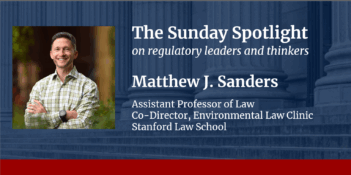
Study advocates for cumulative risk assessment mandates in environmental laws.
One of the primary objectives of the U.S. Environmental Protection Agency (EPA) is to safeguard human health. But when it comes to chemicals and pesticides, do federal environmental laws—and the regulations designed to implement them—adequately protect against repeated exposure to toxins over long periods of time?
At least one scholar believes that they do not. In a recent paper, Sanne Knudsen, an associate professor at the University of Washington School of Law, argues that the government’s approach to protecting human health largely ignores a significant issue: the cumulative risk posed by chemicals and pesticides. According to Knudsen, cumulative risk represents the combined impact on human health from exposure to hundreds of toxins through various pathways.
Some federal environmental laws, such as the Clean Air Act and the Clean Water Act, attempt to regulate the cumulative risks arising from exposure to air and water pollutants. However, Knudsen notes that the laws designed to regulate chemicals and pesticides—the Toxic Substances Control Act (TSCA) and the Federal Insecticide, Fungicide, and Rodenticide Act (FIFRA), respectively—do not address the cumulative impacts of exposure. Although both statutes include information-forcing measures requiring manufacturers to disclose details about their production of chemicals and pesticides, they do not mandate risk assessments.
In addition, recent efforts to reform environmental laws have failed to explicitly address cumulative risk. For example, in June 2016, President Obama signed the Frank R. Lautenberg Chemical Safety for the 21st Century Act (Chemical Safety Act) into law as an amendment to TSCA. The Chemical Safety Act requires EPA to evaluate existing chemicals and establishes new risk-based safety standards, but it does not mandate that EPA, states, or regulated entities perform cumulative risk assessments.
Knudsen contends that the problem is exacerbated by a common, but false, belief that individuals can control their own toxic risk profiles. Instead, Knudsen says that individuals lack the basic information required to understand the risks posed by long-term exposure to chemicals and pesticides, and they do not have the expertise to evaluate risks from exposure to numerous toxins that interact with one another.
Because of the complex nature of interactions among the many chemicals and pesticides that proliferate in the United States, Knudsen emphasizes the potential for so-called “synergistic” harm, where the presence of contemporaneous poisonous substances amplifies their combined danger. For instance, Knudsen points to an EPA study of disinfectant chemicals in chlorinated drinking water in which researchers reportedly found a correlation between exposure to a combination of toxins and various maladies—including reproductive and developmental damage, as well as cancer.
These concerns over the dangers posed by the interaction of multiple toxins lead Knudsen to conclude that current regulatory measures aimed at promoting consumer choice, such as chemical labeling and information disclosure requirements, are inadequate to mitigate the hazards of chemicals and pesticides.
On the other hand, some scholars embrace information disclosure as an effective policy option for managing the risks from toxic substances. For example, Vanderbilt University researcher W. Kip Viscusi and economist Ted Gayer of the Brookings Institution argue that regulators should adopt a cost-effectiveness approach that respects the varying risk tolerances among individuals. Such an approach requires manufacturers and employers to provide hazard warnings to individuals, who can then determine for themselves whether to accept the risks associated with exposure to chemicals and pesticides.
For an example of one such labeling scheme, regulatory reformers might look to the Occupational Safety and Health Administration (OSHA), which requires labeling of hazardous chemicals under its Hazard Communication Standard. OSHA claims that, by providing greater access to information, workers will be able to avoid illnesses from exposure to hazardous substances, such as asbestos.
According to Viscusi and Gayer, this is a preferable approach to regulation of chemicals and pesticides. By empowering individuals to make decisions on their own, they argue, regulators foster improved market performance without imposing additional regulatory burdens.
Despite acknowledging the potential benefits of information disclosure requirements, Knudsen warns that the lack of regulatory measures targeting the cumulative effects of exposure to chemicals and pesticides means that tens of thousands of substances circulate within the United States, even as regulators and the public have only limited knowledge of their long-term health effects.
Specifically, EPA data reveals that, in any given year in the United States, over 85,000 chemicals are manufactured and distributed, and about 675 active pesticide ingredients are sprayed.
In one study of the cumulative effects from pesticides, for example, researchers found traces of eight common pesticides known as organophosphates in food, drinking water, and residential housing. Low-level exposure to these widespread pesticides can reportedly increase the risk of neurological disorders over time, including the well-known attention-deficit/hyperactivity disorder.
With few assurances of safety and little consideration of the overall effect of these substances, Knudsen argues that we face a “daunting collective action problem” that requires a heightened regulatory response. The risk is further elevated, according to Knudsen, by the persistent nature of some chemicals like PCB and other dioxin-like substances whose harmful effects do not dissipate with time.
To properly address this issue, Knudsen proposes that EPA incorporate cumulative risk assessments into its process for making initial determinations of whether chemicals and pesticides meet applicable safety standards. Also, Knudsen explains, the regulatory framework necessary to incorporate cumulative risk analysis into EPA regulations already exists, since EPA has the authority to protect against “unreasonable risk” under the Chemical Safety Act and “unreasonable adverse effects” under FIFRA.
Despite urging consideration of cumulative risk in chemicals and pesticides regulation, Knudsen acknowledges the difficulty of gathering large-scale toxicity and exposure data. In addition, she recognizes numerous potential policy hurdles that a regulator would face after performing a cumulative risk analysis, including deciding which risks to target and implementing appropriate regulation.
Nevertheless, Knudsen argues that, by incorporating cumulative risk assessments in the regulation of chemicals and pesticides, regulators can address an important—but neglected— dimension of their mission to protect human health.



